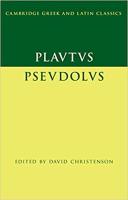
CUP (2020) p/b 408pp £24.99 (ISBN 9780521149716)
This commentary on Pseudolus (in the Green and Yellow series) is the first since M.M. Willcock’s admirable (but naturally smaller scale) edition of 1987 for Bristol Classical Press. It opens with a long Introduction:
(1) Plautus the Playwright: this shows us how little we know about him: his life is traditionally dated from 254 to 184 BC, in which case Pseudolus, known to have been produced in 191 BC, will have been one of his later plays.
(2) The Roman Appropriation of Greek Comedy. There was not a straightforward ‘journey’ from the Athens of Menander (ca. 300 BC) to Rome: rather, the transfer was mediated via the mimes and fabulae palliatae of the Greek cities of Sicily and Magna Graecia. Plautus was the first Roman to write comedies, and they were very different from their Greek predecessors; we have no knowledge of the Greek play which Plautus with Pseudolus vortit barbare. (A detailed comparison by C. of a papyrus section of Dis Exapatôn with Bacchides might reasonably have been deferred to an Appendix, or even exchanged for consideration of E. Fraenkel’s account of lines 133-393 [Plautine Elements in Plautus, pp. 97-101 in the 2007 English translation.] C.’s full introduction to the scene makes no reference to Fraenkel.)
(3) Pseudolus: Plot, Characters and Poetics. The plot is structured round the efforts of the ‘hero’ to find, on behalf of his master Calidorus, the 20 minae needed to buy the girl Phoenicium from the pimp Ballio before a soldier—who has already paid 15 minae—can do so: some of the complex machinations are well summed up by a diagram in Willcock (p.16). C. gives character summaries of the main dramatis personae. Pseudolus is shown—as his name implies—to be a master of deception and trickery, as well as a supreme parodist and socially mobile eirôn. The other most important character, Ballio, the pimp is introduced by C. as follows: ‘in actantial Greimassian terms Ballio is…’ etc. To these unheralded and perhaps unhelpful words C. does not add that Greimas was a 20th century Lithuanian semiotician of the school of Saussure, Barthes, etc. That said, Ballio’s unpleasant and sadistic character is well brought out: he ‘displays linguistic brilliance, though suffused with the pimp’s diseased imagination’. Pseudolus is a notably lively play, but C. sees more: (the play) ‘celebrated the imaginative potential of world-building within a constraining order enshrined in traditional authority’ … ‘The irreverence of Plautus not only reflects a general preference for farce over naturalism [sc. of Menander], but constitutes a poetics of rebellion. The time is ripe for critics to fully embrace and develop the notion of Plautus as a sophisticated Hellenistic and intertextual poet’. There is a useful summary of the play’s 21 scenes on pp. 31-2; but C.’s thoughts on the possible final disposition of the cash (p. 25) take us ‘out of the drama’ and are as irrelevant to us as they would have been to the playgoers at the time.
(4) Language. C. gives a very full account of Plautus’ ‘heteroglossic mastery of language’; indeed, he lists about 20 artificial elements which define his characters’ language as idiosyncratic, though here only the cook (Cocus) matches Pseudolus in verbal ingenuity and ‘hybrid linguistic inventions’. (It would have been interesting to see how many hapax legomena are to be found in the play: some help is provided by the Index entry svv. on p. 385). But here again C. invests the language with a greater significance: ‘By constantly exposing language’s instability and extending its polyvalence through figurative substitutions and analogy, both characters [i.e. cook and Pseudolus] manifest a constructivist outlook of the world as they supplant common assumptions and conventionality with refreshed perspectives and unrealised truths’… ‘we are invited to take a fresh, interrogative look at our social world. In this way, the cook’s aggressively creative agency models Plautus’ translation project.’
(5) Music and metre. ‘Pseudolus is one of Plautus’ musically richest plays and features frequent changes of metre’. Just so, and this is a long (11 pages) and admirably detailed section, with, for example, the lex brevis brevians well explained, and the ‘laws’ of Luchs, Ritschl, Hermann and Meyer clearly set out.
(6) Text and transmission. The textual tradition is not complicated (Willcock’s account is notably full and clear) nor are there many serious difficulties (line 422 presents a small but unexplained puzzle). C.’s text comes without an apparatus criticus, in line with established policy for the Green and Yellow series, leaving textual difficulties to be dealt with in the Commentary. The fact that even the Loeb edition by de Melo has a modest apparatus of over 100 items serves to remind us that our text ‘does not come straight from heaven’. Willcock provides an apparatus on a slightly larger scale.
(7) Reception. Revival performances of Plautus began shortly after his death and continued through at least the late Republic—Cicero twice mentions this play in his speeches, which argues for its popularity.
The Commentary—roughly twice the length of that offered by Willcock—annotates the text in detail, but a conspicuous feature is the frequency of notes which merely say (e.g.) ‘90n.’, and seems to mark a sharp downward trajectory in the editor’s expectations of his readers’ familiarity with Latin. Examples are far too numerous to list, but (at random) autem translated as ‘but’, et = ‘and yet’, sola = ‘single-handedly’, tenes = ‘you understand’, scivi = ‘I’ve found out’, audes = ‘you want to’, vives = ‘you’ll survive’, vel ‘even’, si possim = ‘even if I could’, noscere = ‘determine’, senserit = future perfect, facturum = facturum esse, tute = tu + the intensive suffix te , are examples which may give the flavour. The publishers refer to the book as being ‘of interest’ to students and scholars: that is valid, and the disjunction is clear, whether or not intended.
There is a bibliography, and Indexes of Subjects and Latin words, and an Index locorum.
Colin Leach
